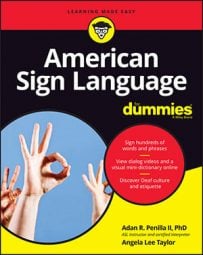When you engage in Constructed Dialogue, keep a couple of things in mind: Make sure the person with whom you're signing knows the names of the people you're talking about and also what the gist of the conversation between the two people was.
Here's a scenario to show you how Constructed Dialogue works: Sheri and Buddy are talking about Sheri's upcoming wedding. Sheri wants to let Buddy know that her aunts can't agree on the color of the cake. Sheri has already shared with Buddy what the problem is, who is involved, and their general thoughts on the subject.Sheri shifts her body/waist to the left slightly and takes on the role of Aunt Dee, signing Aunt Dee's name once. After the shift, Sherri doesn't need to sign Aunt Dee's name again; she can just shift her body to the left. Aunt Dee, when referred to, remains in this position for the duration of the conversation.
Sheri signs: Orange and cream are too Halloween-like; people are going to think it's a costume party.
Because only two people are involved in the dialogue and Buddy knows who they are, introducing the name of the other participant, Aunt Denni, isn't necessary, but Sheri may sign Aunt Denni's name just to make sure she is clear.
Sheri shifts her body slightly to the right and begins to respond as if she is Aunt Denni: Don't be silly, orange is Sheri's favorite color, and it is her big day after all.
Sheri shifts to the left again, assuming Aunt Dee's position, and signs: I think we need another opinion.
Sheri shifts to the right again, taking on the role of Aunt Denni, and signs: That really isn't necessary.
After you understand the idea of Constructed Dialogue, start practicing it with others. You'll find that recalling the past with others isn't that difficult and that doing so adds a little complexity to your signing, allowing you to follow others with more certainty as they use Constructed Dialogue.

